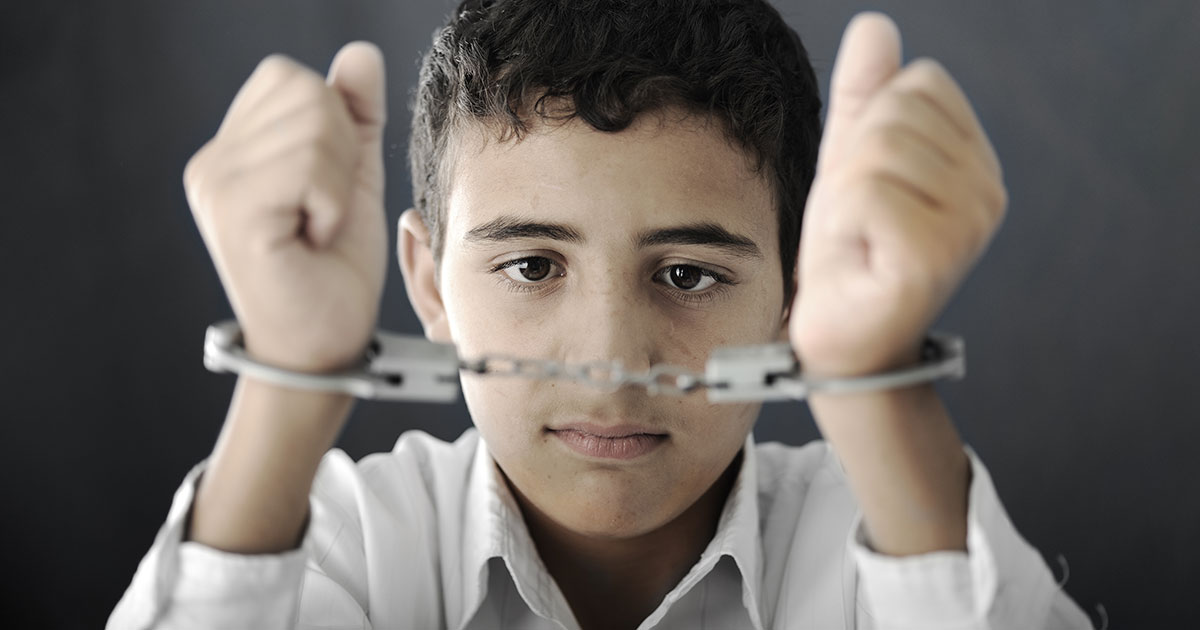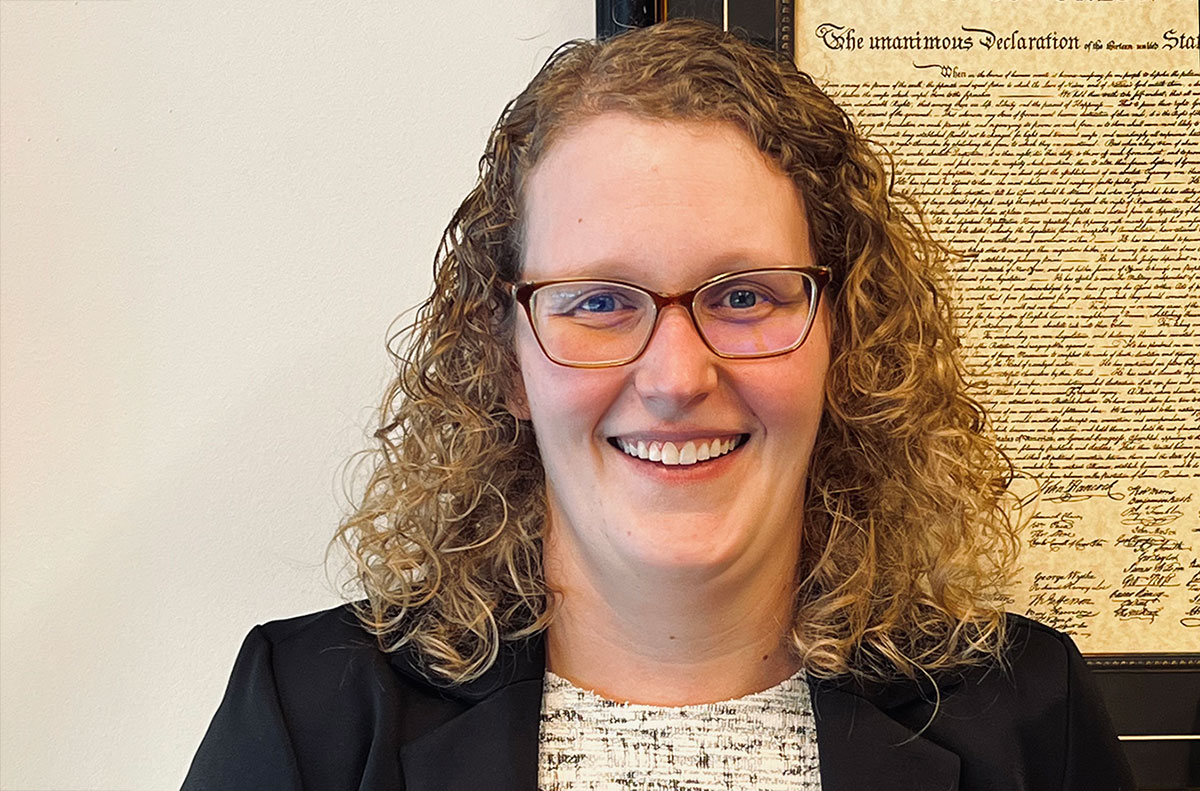
Dec. 15, 2021 – Public defender Eileen Fredericks remembers the first time the consequences of shackling juvenile defendants became real to her.
Frederick’s client, a child who’d suffered long-term physical abuse at the hands of his mother’s partner, was led into court in ankle shackles attached to a belly chain. When the proceeding was over, a deputy moved to take Fredericks’ client back to detention.
“And without letting him know that they were going to be grabbing the belt behind, as they were ushering him out of the courtroom they grabbed that and he jumped and had this reaction,” Fredericks said.
The child’s response was a normal trauma response, Fredericks said. But the judge upbraided her client for acting out.
“That’s like somebody coming up behind him and abusing him and then having that similar feeling, which he wouldn’t have done if he didn’t have that belly chain behind him,” Fredericks said.
“It wouldn’t have been this jolt to his whole body. That was a huge light-bulb moment for me, about how difficult this is for some of these kids.”
Wisconsin in the Minority
A
rule petition filed with the Wisconsin Supreme Court would allow juveniles to be shackled only where a court finds that shackles are necessary because the juvenile presents a threat of harm, has a history of disruptive courtroom behavior, or presents a flight risk.
 Jeff M. Brown is a legal writer for the State Bar of Wisconsin, Madison. He can be reached by email or by phone at (608) 250-6126.
Jeff M. Brown is a legal writer for the State Bar of Wisconsin, Madison. He can be reached by email or by phone at (608) 250-6126.
Additionally, the court would need to find that there are no less restrictive alternatives to shackling.
Currently, in 25 counties across Wisconsin, juvenile defendants are routinely shackled for court appearances as a matter of course, without any individualized determination as to the risk of flight or violence.
In eight other counties, judges defer to the sheriff to determine whether a juvenile should be shackled.
Five counties, however – Dane, Eau Claire, La Crosse, Marathon, and Milwaukee counties – have adopted local court rules or practices that establish a presumption against shackling juveniles. The presumption can be overcome upon a finding made on the record that the juvenile is likely to flee or cause harm to himself, herself or others.
A survey of officials in the five counties that have adopted rules similar to the one proposed in the petition reports few problems caused by unshackled juveniles.
The State Bar of Wisconsin’s Board of Governors
voted unanimously in September 2019 to adopt policy position against the indiscriminate shackling of juveniles. At its meeting this month, the board
voted by consent to support the petition.
If the supreme court adopts the rule, Wisconsin will join 33 other states and the District of Columbia in acting to effectively bar the indiscriminate shackling of juveniles.
‘Inherently Humiliating’
In their memorandum in support of the petition, petitioners cite a
resolution adopted by the National Council of Juvenile and Family Court Judges that urges state judiciaries to lead on the issue of juvenile shackling.
According to the memo authors, the law has “long recognized that shackling is inherently humiliating. “This shame and humiliation is especially damaging to adolescents, who are in the developmental process of forming their own identities and who are intensely concerned with how others perceive them.
“Shame and humiliation, unfortunately, ‘can lead to maladaptive behaviors such as defensiveness, avoidance, and aggression.’ Because of their developmental status, adolescents are also at an increased risk of internalizing the perception that they need to be shackled to avoid harming others.”
According to the memo, the American Academy of Child and Adolescent Psychiatry has said that shackling should be used only after an individualized determination that it’s necessary to ensure safety.
In a
supporting memo, the petitioners say that public defenders are trained to object to the shackling, but a survey in 2020 revealed that hundreds of juveniles continue to be shackled during courtroom proceedings.
“Many of these children are not shackled because the court has found them likely to flee, or likely to be disruptive in the courtroom,” the memo notes. “They are shackled simply because it is routine – sometimes based on a sheriff’s policy, sometimes because it is the way it’s always been done.”

"We want to maintain the order, decorum, and safety in the courtroom for everybody. That’s the goal. How do we make sure that our courtrooms are safe and that people are treated with respect and dignity, because that really matters at the end of the day." – Judge Laura Crivello
‘It Can Be Really Dehumanizing’
Public defender Alaina Fahley says her experience backs up the claims about the harms of shackling cited in the memorandum.
“Sometimes their feet don’t even reach the ground,” Fahley said of her clients, who are typically aged 12 to 17 but can be as young as 10. “It can be really dehumanizing.”
Fahley also said that shackling juveniles often predisposes them to believe the worst about themselves. Those beliefs, she said, often act as a roadblock to rehabilitation.
“I’ve had clients say ‘Why am I going to have a day in court … they already think I did this. They already think I’m horrible, they already think I’m a monster.’”
Fahley practices in Brown County – one of the counties where indiscriminate shackling of juveniles is policy – and Outagamie County, where judges often defer to the sheriff when it comes to shackling juveniles.
She said the current patchwork of policies on juvenile shackling across the state’s 72 counties has created a “county-by-county set of justice.”
Shackling Affects Conduct of Hearings
The indiscriminate shackling of juveniles often affects the conduct of court proceedings.
According to Diane Rondini, one of the petitioners and a retired public defender who practiced in Dane and Milwaukee counties, handcuffs make it hard to sign documents. Leg and chest restraints can chafe, and the discomfort distracts juveniles from paying attention to the hearing or what the judge is saying.
Beyond making juveniles believe the worst about themselves, said Fredericks, indiscriminate shackling prevents them from fully participating in court proceedings
“Shackling invites dysregulation,” Fredericks said. “Kids can be appropriate in court. There isn’t a need for these kids to be shackled … I think it’s just totally unnecessary in most cases.”
The thoughts that shackling sends racing through juveniles’ heads often become a self-fulfilling prophecy, Fahley said.
“Most of the time there’s not really a true safety concern – there’s already been this label that this kid is dangerous and we’re not giving them the chance to prove that they’re able to cooperate in court.”
Two retired public defenders and five circuit court judges have petitioned the Wisconsin Supreme Court to adopt a rule that would establish a presumption against shackling juvenile defendants. Eileen Fredericks and Alaina Fahley, both public defenders share their views on shackling.
Patchwork of Policies is Problematic
Rondini, who is one of the petitioners, first became active on the issue when she served on the board of the State Bar’s Children and the Law section.
Even in the counties that allow defense lawyers to object to a juvenile being shackled, Rondini said, timelines established in state statute get in the way.
The appearance at which a juvenile is most likely to be shackled is a detention hearing, which by law must occur within 24 hours of the juvenile’s arrest. But court rules require a juvenile’s lawyer to provide 72 hours’ notice before making a motion, including a motion that a juvenile not be shackled during his or her court appearance.
That means there’s no way for the lawyer to make a timely motion for the juvenile not to be shackled at his or her detention hearing.
In addition to the patchwork of policies on whether juveniles are to be shackled, the lack of a statewide policies means that circuit court’s responses to anti-shackling motions “are all over the place,” said Eileen A. Hirsch, another one of the petitioners and, like Rondini, a retired public defender.
Some courts deny such motions as a matter of course; others grant them as a matter of course, Hirsch said. Others take each motion on a case-by-case basis.
Additionally, said Rondini, it’s difficult for overworked public defenders to find the time to file motions related to shackling when they’re preparing to address to substantive issues likely to be adjudicated in the hearing.
“The petition, without micromanaging, would help provide standards and guidance to the courts,” Rondini said.

"When I have clients who are not shackled, there is more of a perception – and a reality – of fairness. When they’re not focused on the physical harm that their receiving or even the psychological harm that this is doing to them, I think they’re able to participate better." – Alaina Fahley, Public Defender
‘Kids Just Sit Up Straighter Now’
Rondini said adopting the rule would adopt a standard for shackling juveniles that matches the standard for whether adults should be shackled – whether doing so is necessary to maintain order, decorum, and safety. The Wisconsin Supreme Court established that standard in
State v. Grinder, 190 Wis. 2d 541, 527 N.W.2d 326 (1995).
In
Grinder, the supreme court ruled that the circuit court erred by exercising its discretion to rely primarily upon the sheriff’s department procedures in deciding whether to shackle an adult defendant instead of considering his particular risk of violence or escape.
Fredericks said the move away from indiscriminate shackling in Dane County, where she practices, has made a difference.
“Kids just sit up straighter now in court, and they seem like they’re more engaged, and they can listen better, and some kids will ask me for a pen and write notes, but before I couldn’t even have them write anything or sign something because they’d have the shackles,” Fredericks said.
At the heart of requiring an individualized determination on whether a juvenile should be shackled is the issue of a fairness, Fahley said. And because children are “fairness fanatics,” policies that allow shackling only where necessary lead to more buy-in from defendants.
“When I have clients who are not shackled, there is more of a perception – and a reality – of fairness,” Fahley said. “When they’re not focused on the physical harm that they’re receiving or even the psychological harm that this is doing to them, I think they’re able to participate better.”
Adoption of the proposed rule would also place the authority to make shackling decisions in judges, and eliminate the arbitrariness of shackling decisions that results from the state’s maze of policies, Fahley said.
“The idea that there is different justice based on what your zip code is or what country you’re living in … it’s just not fair and it doesn’t seem fair for these children, and I know that I have clients who are aware of that.”

"Kids can be appropriate in court. There isn’t a need for these kids to be shackled…I think it’s just totally unnecessary in most cases." – Eileen Fredericks, Public Defender
‘It Should Be an Individual Decision’
It’s not just defense lawyers who’ve signed on to the petition – five judges have too.
Judge Laura Crivello, who presides over children’s court in Milwaukee County, is one of them. The others are Judge Ramona A. Gonzalez (La Crosse County), Judge Everett Mitchell (Dane County), Judge Suzanne C. O’Neill (Marathon County), and Judge Michael A. Schumacher (Eau Claire County).
Crivello said the first change she made when she became presiding judge in 2019 was to eliminate the indiscriminate shackling of juveniles.
“The more I read about and learned about the development of our youth and how they see themselves, the trauma that I believe they were sustaining by coming into court and treated as criminal … it seemed wrong,” Crivello said.
“There was a need to change it and have a rational discussion relative to each particular child. It should be an individual decision, it shouldn’t just be based on policy.”
Continuing to shackle all juveniles just because it had always been done, said Crivello, “didn’t seem real wise to me. Or logical.”
Additionally, said Crivello, she learned through trainings and research that “kids perform to the level of what we expect from them.” Shackling juveniles, said Crivello, too often set them up to believe the worst about themselves and behave accordingly.
Crivello saw from the bench some of the same things defense lawyers were seeing when it came to how shackles affected their client’s behavior.
“You have a kid whose identity is developing, and the first thing that they do is walk in in shackles. They spend more of the time [in court] not listening to you or the people around them but focusing on ‘What’s around my ankles, what’s around my wrists?’”

"It’s kind of the way things are going in the country. They’re realizing the effects on children, on the family and the court process, and I think the court will recognize that authority." – Diane Rondini, former public defender
Respect and Dignity
Crivello made the change after getting the OK from Chief Judge Mary E. Triggiano and sitting down with stakeholders to determine the right way to make the change.
“We want to maintain the order, decorum, and safety in the courtroom for everybody,” Crivello said. “That’s the goal. How do we make sure that our courtrooms are safe and that people are treated with respect and dignity, because that really matters at the end of the day.”
Crivello, who worked as an assistant district attorney for 24 years, admits that shackling juveniles is sometimes warranted.
“And yet that should be a case-by-case determination with a judicial review with, ultimately, findings being made … But it shouldn’t be in every situation.”
After leading the charge to change Milwaukee County’s policy on juvenile shackling, Crivello said, signing on to the supreme court rule petition “seemed like a natural thing.”
“The ideology of having the indiscriminate use of restraints, I don’t see how people could not be aligned with that, if you think it through. How is it good sense, how is it good policy? Why wouldn’t you want to jump on this bandwagon and change up how we’re doing things?”
‘It’s Just the Right Thing to Do’
Fahley sees adoption of the petition as a way to support the juvenile system’s rehabilitative efforts.
“The more restrictive we make that court system, the more likely that kid is to come back in,” she said. “If we can be looking at kids and giving them the opportunity, I think they can rise to that occasion, and I think that’s what we’re not allowing them to do when there’s this presumption for shackling.”
Rondini is optimistic the supreme court will adopt the petition.
“This is not a novel idea,” Rondini said. “It’s kind of the way things are going in the country. They’re realizing the effects on children, on the family and the court process, and I think the court will recognize that authority.”
Judge Crivello said she plans on attending the hearing on the petition, which is scheduled for Feb. 15, 2022. She’s confident her fellow jurists will support it.
“It’s in compliance with the law, it’s in compliance with best practices, it’s addressing trauma, it’s addressing research, and it’s just the right thing to do.”
